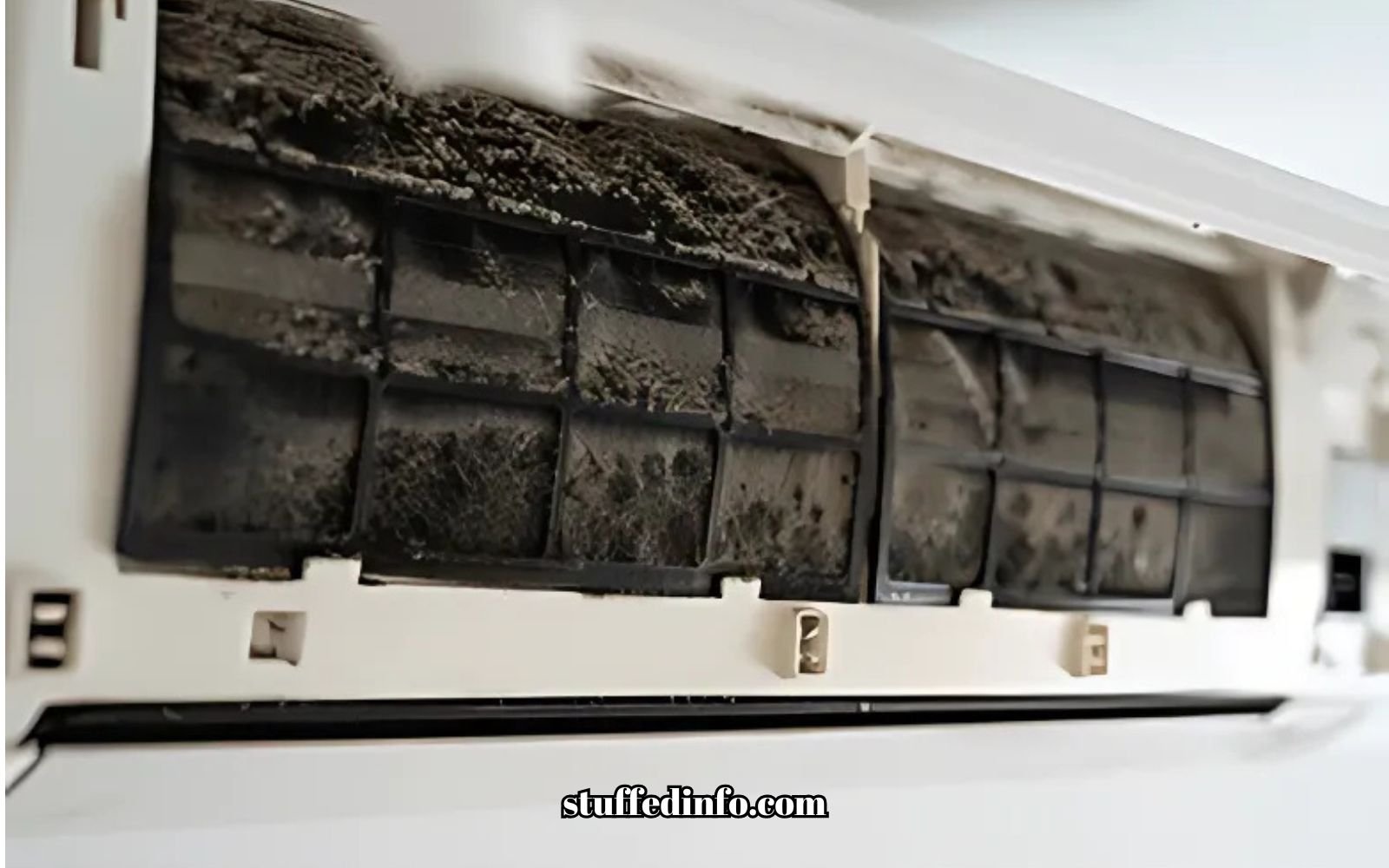Air conditioning is important for keeping the room cool, especially when it gets hot outside. Sometimes, though, you might notice some black stuff from air conditioner units. This black residue can be a sign of problems that could affect the air you breathe and how well your air conditioner works. Hence, it is crucial to deal with this issue because ignoring it might lead to bigger problems later. In this blog post, we will look at what is black stuff from air conditioners, its causes, and how it affects your air conditioning system. Moreover, it sheds light on the AC Cleaning and maintenance steps to avoid black stuff. No need to delay any more – start reading this post right away.
Table of Contents
ToggleWhat Is the Black Stuff from Air Conditioners?
The black stuff from air conditioners is usually mold or mildew, along with dust. It looks dark and fuzzy, feels damp and sponge-like, and smells musty. This stuff grows in humid conditions, so it is common in AC units. You often find it in filters, where it gathers moisture, in ducts where air does not flow well, and on coils that can hold water.
Why Is Black Stuff Accumulated In Air Conditioners?
Air conditioners help keep our environment cool but sometimes they collect black stuff inside. Knowing why this happens helps our homes be comfortable and the air we breathe clean. So, here are some common reasons why black stuff accumulates in air conditioners.
- Dust And Dirt Accumulation: Dirt and dust can get into your AC units through the vents. After some time, this build-up creates a black residue that can further block airflow. Moreover, it may also make the system less effective.
- Mold And Mildew Growth: The moisture from the cooling system can also create a moist space within the unit. Hence, it helps mildew and mold to grow. As a result, this can appear as black spots and also impact the air you breathe.
- Poor Ventilation: If you haven’t gotten your AC serviced, its ventilation may weaken and further black stuff may get accumulated. As a result, it will not be able to cool down the room.
- Soot from Fireplace Logs And Candles: When you burn candles or logs in a fireplace, they extricate soot into the air. The air conditioner can further pull this soot and create a black coating inside.
By taking care of our air conditioners and understanding what causes the black stuff, we can avoid a lot of problems. Hence, this keeps our air healthy and makes our AC units last longer.
Simple Signs To Identify Black Stuff In Air Conditioners
Air conditioners can collect dirt and other things over time. Hence, you need to identify certain black stuff using the following simple signs:
Black Spots

If you see any small black dots on your AC vents or nearby spots, it might possibly be mold. These spots can further grow in humid places, showcasing that moisture control is not working well.
Mold in Air Ducts And Vents
If you find any mold in your AC vents or ducts, it can eventually block airflow and make your AC less efficient. This often happens due to moisture being trapped inside.
Musty Odor
A constant musty odor coming from your Air Conditioner generally means there is some mold. This smell comes from mold spores, and it is a sign that checking and cleaning are needed right away.

By learning to identify these easy signs of black stuff, you can clean your AC unit and keep it running smoothly. This will further help you to make your home healthier for you and your family.
Impact Of Black Stuff On The Air Conditioner’s Performance
Black stuff from air conditioners can make them work poorly. Knowing how this buildup affects cooling helps us keep our homes comfortable and the air we breathe cleaner. So, here is the impact of black stuff on the air conditioner’s performance.
Decreased Airflow
Black stuff (such as dirt and dust) can block air ducts and filters. This blockage further makes it difficult for air to flow uninterrupted. As a result, your AC has to work much harder, which can also make your home warmer.
Increased Energy Consumption
When airflow is blocked in the air conditioner, it uses extra energy to cool down your home. Thus, this means higher electrical bills. But regular maintenance and cleaning help keep electricity costs down.
Risk Of System Failure
Too much dirt and debris can lead your AC to overheat and put emphasis on important parts, such as the compressor. As a result, this can further lead to costly repairs, breakdowns, or the need to displace the entire system.
Cleaning the AC units and removing the black stuff helps them work better and last longer. Regular care is crucial for effective cooling and keeping the air healthy.
How To Get Rid Of Black Stuff In Air Conditioners?
To remove the black stuff from air conditioners, you need to follow the step-by-step process in the following section.
- Get Your AC Serviced: Have your AC units checked at least once every year. It further helps in preventing mold and keeps you away from respiratory issues. Moreover, the service cost is generally low.
- Deeply Clean The Indoor Coil: You need to hire a professional to clean the indoor coil. They will use a pressure washer to spotlessly clean the cooling coil. Moreover, they will also remove dirt and mold that builds up.
- Clear Debris From Return Air Filters: You should also check your air filters once every 3 months. But if they are still dirty after a thorough cleaning process, you need to call a technician to get them replaced for better air quality.
Cleaning the AC units regularly can stop the black stuff from coming back. By following these easy steps, you can make sure your units work well and keep your air fresh.
Safety Precautions To Follow While Cleaning Black Stuff From Air Conditioners
Cleaning black stuff from air conditioners is essential, but you also need to be safe. Following easy safety tips helps you stay protected while keeping your units clean and air fresh.
- Turn Off The AC And Unplug It: Start by turning off your air conditioner and then unplug from the wall. This will further keep your AC safe while you work on it and prevent any possible electrical issues.

- Wear Safety Gear: Before you begin attempting to clean the AC, you should put on certain safety gear, such as goggles and gloves. This will further protect you from flying dust and sharp parts, further making sure that you remain safe while working.
- Let The AC Dry: After repairing or cleaning your AC unit, you must let it completely dry. As a result, this will stop bad smells and mold. Moreover, you must ensure it is dry from the inside out before you start using it again.
By being careful when you clean the AC units, you protect yourself as well as your air conditioner. Staying safe makes cleaning easier.
In Conclusion
Air conditioners are crucial for keeping the room cool during the summer season, but they can sometimes form black stuff. It is generally mold or mildew and it can make the air in the atmosphere unhealthy and may affect the working of your AC. It often forms due to dirt, dust, and moisture.
Hence, this blog post gives away some simple signs to identify what is black stuff from air conditioners and why it is fathered in air conditioners. Subsequently, it dives into the impact of black stuff on the air conditioner’s performance. Following this, it investigates different methods to get rid of black stuff in air conditioners. Finally, it examines the safety precautions to follow while cleaning black stuff.
FAQs
Question. Are there any health effects of black stuff from air conditioners?
Answer. There are several health effects of black stuff from air conditioners. Yet, some common health effects include allergic reactions, respiratory issues, and infections. These health issues are caused by mold spores.
Question. How often should we clean the AC to stop the black stuff from spreading?
Answer. It’s good to have your AC checked at least once every year. You should also look at their air filters every 3 months.
Question. How can we stop moisture from building up in the Air Conditioner?
Answer. Insulate your AC ducts carefully, keep the indoor humidity level steady, and clean (or change) the filters at regular intervals.







